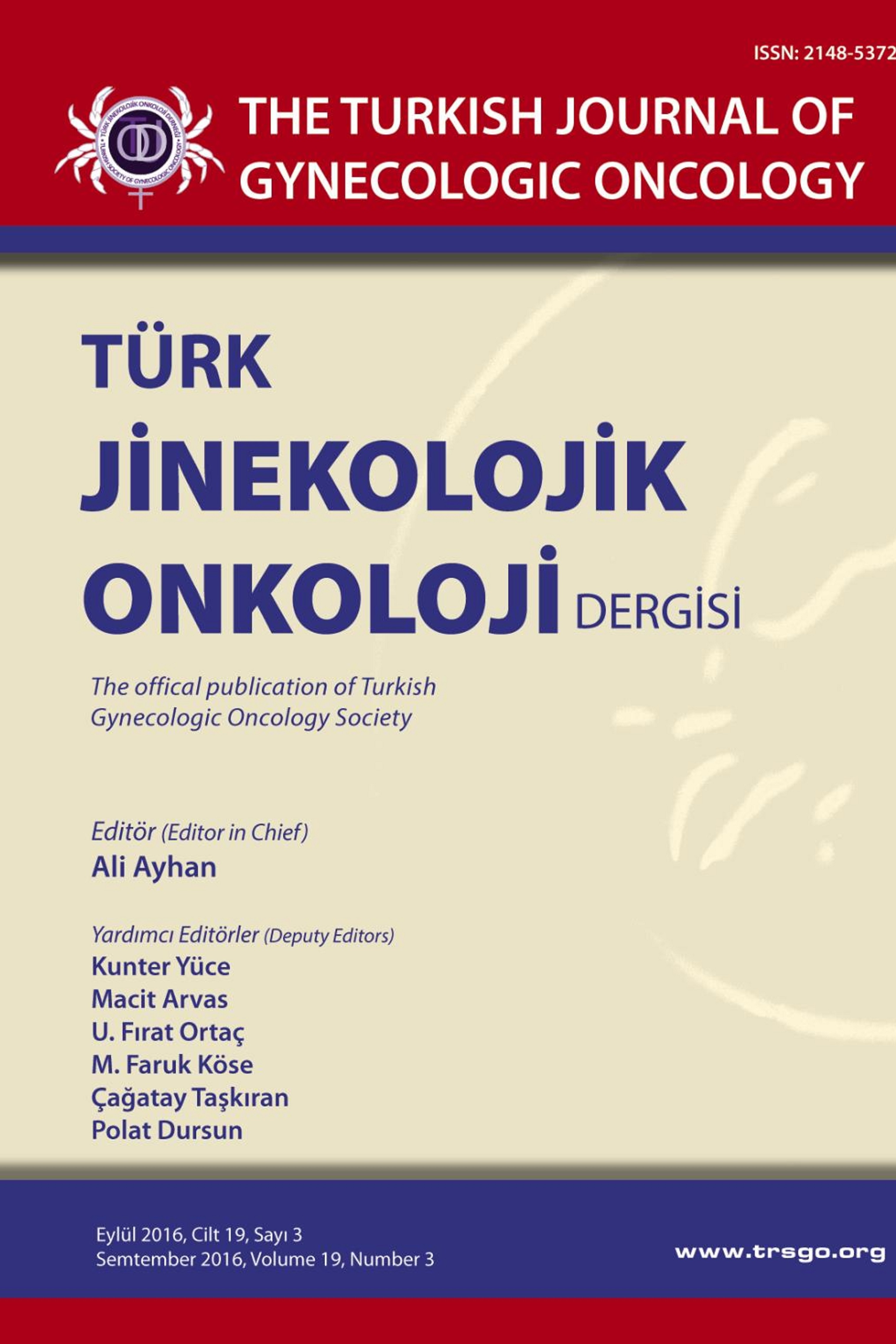ANORMAL SERVİKAL SİTOLOJİLİ HASTALARDA SİTOLOJİK VE HİSTOPATOLOJİK SONUÇLARIN KARŞILAŞTIRILMASI
Amaç: Servikal kanser taramasında sitolojik inceleme altın standart olmakla beraber anormal servikal sitoloji saptanmada kolposkopik biyopsi ve konizasyon sonuçları arasında uyumsuzluklar saptanabilmektedir. Çalışmamızda, anormal servikal sitoloji sonuçları ile kolposkopik biyopsi ve histopatolojik tanı sonuçları karşılaştırılması amaçlandı. Materyal- Metod: Servikal sitoloji sonuçlarına göre ASCUS, ASCH, LSIL, HSIL tanısı alan hastalar çalışmaya dahil edilmiştir. Çalışmaya dahil edilen tüm hastalara kolposkopi ve/veya servikal biopsi yapılmış olup kolposkopik biopside servikal displazi saptanan hastalara LEEP/konizasyon proseduru uygulanmıştır. Bulgular: Servikal sitoloji sonuçlarına göre ASCUS, n = 45; ASCH, n = 9; LSIL, n = 85 ve HSIL, n = 47 olmak üzere toplam 186 olgu çalışmaya dahil edildi. Kolposkopik biopsi sonucunda; kronik servisit (n = 32, %17,2), LSIL (n = 90, %48,4) ve HSIL (n = 64, %34,4) tespit edildi. Kolposkopik biopside anormallik saptanan 107 hastaya LEEP/Konizasyon yapıldı. Histopatolojik sonuçlarda; kronik servisit (n = 5, %4,7), LSIL (n = 34, %31,8), HSIL (n = 62, %58) ve invaziv servikal karsinom (n = 6, %5,6) olarak tespit edildi. LEEP ve konizasyonla HSIL tespit edilen 62 olgu incelendiğinde servikal sitolojide (n = 36) %58‘nde HSIL tespit edilebilirken, 15 olgu (%24,2) LSIL, 5 olgu (%8) ASCUS, 6 olgu (%9,7) ise ASC-H olarak tanı almıştır. Buna karşın LEEP sonucu HSIL tanısı alan 62 hastanın kolposkopik biyopsi sonuçları incelendiğinde; 53 olgu (%85,5) HSIL tanısı almış, LSIL 7 olguda (%11,3) ve kronik servisit 2 olguda (%3,2) saptandı. Sonuç: Servikal sitolojik tarama günümüzde hala en etkin ve kolay yöntem olmakla beraber anormal servikal sitolojilerin değerlendirilmesinde yetersizlik görülmektedir. Anormal servikal sitolojilerin değerlendirilmesinde en uygun yöntem kolposkopi eşliğinde gerekirse servikal biyopsi yapılması ve histolojik olarak değerlendirilmesi uygun görülmektedir.
Objective: Although cytological examination is gold standard for cervical cancer screening for abnormal cervical cytology, It can ve detected between colposcopic biopsy and conization results have discrepancies. In our study, the results of abnormal cervical cytology, colposcopy with biopsy and histopathological diagnosis was to compare the results. Materials and Methods: According to the results of cervical cytology, ASCUS, ASC-H, LSIL, HSIL diagnosed patients were included in the study. All patients included in the study colposcopy and / or cervical biopsies and cervical dysplasia in patients who were observed colposcopic biopsy LEEP/conization procedure was applied. Results: According to the results of cervical cytology, ASCUS, n = 45, ASC-H, n = 9; LSIL, HSIL, and n = 85, n = 47 for a total of 186 patients were included in the study. As a result of colposcopic biopsy, chronic cervicitis (n = 32, 17.2%), LSIL (n = 90, 48.4%) and HSIL (n = 64, 34.4%) were detected. Identified 107 patients with abnormal colposcopic biopsy with LEEP/Conization was performed. Histopathological results; chronic cervicitis (n = 5, 4.7%), LSIL (n = 34, 31.8%), HSIL (n = 62%, 58) and invasive cervical carcinoma (n = 6, 5.6%) was found to be. LEEP and konizasyonla HSIL cervical cytology detected 62 cases examined (n = 36) and 58% at HSIL edilebilirken identified, 15 cases (24.2%) LSIL, 5 patients (8%) ASCUS, 6 cases (9.7%) was diagnosed as ASC-H is. However, as a result of LEEP colposcopic biopsy results of 62 patients with a diagnosis of HSIL is examined, 53 patients (85.5%) with a diagnosis of HSIL, LSIL in 7 cases (11.3%), and chronic cervicitis in 2 cases (3.2%) were detected. Conclusion: Cervical cytologic screening, although still the most effective and easy method of evaluation of abnormal cervical cytology were failure. The most appropriate method of evaluation of abnormal cervical cytology and colposcopy with histologic evaluation if necessary, cervical biopsy is appropriate.
